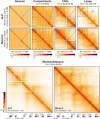The macro and micro of chromosome conformation capture
- PMID: 32987449
- PMCID: PMC8236208
- DOI: 10.1002/wdev.395
The macro and micro of chromosome conformation capture
Abstract
The 3D organization of the genome facilitates gene regulation, replication, and repair, making it a key feature of genomic function and one that remains to be properly understood. Over the past two decades, a variety of chromosome conformation capture (3C) methods have delineated genome folding from megabase-scale compartments and topologically associating domains (TADs) down to kilobase-scale enhancer-promoter interactions. Understanding the functional role of each layer of genome organization is a gateway to understanding cell state, development, and disease. Here, we discuss the evolution of 3C-based technologies for mapping 3D genome organization. We focus on genomics methods and provide a historical account of the development from 3C to Hi-C. We also discuss ChIP-based techniques that focus on 3D genome organization mediated by specific proteins, capture-based methods that focus on particular regions or regulatory elements, 3C-orthogonal methods that do not rely on restriction digestion and proximity ligation, and methods for mapping the DNA-RNA and RNA-RNA interactomes. We consider the biological discoveries that have come from these methods, examine the mechanistic contributions of CTCF, cohesin, and loop extrusion to genomic folding, and detail the 3D genome field's current understanding of nuclear architecture. Finally, we give special consideration to Micro-C as an emerging frontier in chromosome conformation capture and discuss recent Micro-C findings uncovering fine-scale chromatin organization in unprecedented detail. This article is categorized under: Gene Expression and Transcriptional Hierarchies > Regulatory Mechanisms Gene Expression and Transcriptional Hierarchies > Gene Networks and Genomics.
Keywords: 3C technologies; 3D genome; Hi-C; Micro-C; chromosome conformation capture; genomic organization; nuclear architecture.
© 2020 The Authors. WIREs Developmental Biology published by Wiley Periodicals LLC.
Conflict of interest statement
We declare that no competing financial interests exist.
Figures




Similar articles
-
Understanding 3D Genome Organization and Its Effect on Transcriptional Gene Regulation Under Environmental Stress in Plant: A Chromatin Perspective.Front Cell Dev Biol. 2021 Dec 8;9:774719. doi: 10.3389/fcell.2021.774719. eCollection 2021. Front Cell Dev Biol. 2021. PMID: 34957106 Free PMC article. Review.
-
Methods for the Differential Analysis of Hi-C Data.Methods Mol Biol. 2022;2301:61-95. doi: 10.1007/978-1-0716-1390-0_4. Methods Mol Biol. 2022. PMID: 34415531
-
A (3D-Nuclear) Space Odyssey: Making Sense of Hi-C Maps.Genes (Basel). 2019 May 29;10(6):415. doi: 10.3390/genes10060415. Genes (Basel). 2019. PMID: 31146487 Free PMC article. Review.
-
Detecting Long-Range Enhancer-Promoter Interactions by Quantitative Chromosome Conformation Capture.Methods Mol Biol. 2017;1468:51-62. doi: 10.1007/978-1-4939-4035-6_6. Methods Mol Biol. 2017. PMID: 27662870
-
Mapping Mammalian 3D Genomes by Micro-C.Methods Mol Biol. 2022;2532:51-71. doi: 10.1007/978-1-0716-2497-5_4. Methods Mol Biol. 2022. PMID: 35867245
Cited by
-
High-throughput chromosome conformation capture-based analysis of higher-order chromatin structure in nasopharyngeal carcinoma.Ann Transl Med. 2021 Aug;9(16):1314. doi: 10.21037/atm-21-3273. Ann Transl Med. 2021. PMID: 34532451 Free PMC article.
-
Chromosome conformation capture approaches to investigate 3D genome architecture in Ankylosing Spondylitis.Front Genet. 2023 Jan 25;14:1129207. doi: 10.3389/fgene.2023.1129207. eCollection 2023. Front Genet. 2023. PMID: 36760998 Free PMC article.
-
Putative looping factor ZNF143/ZFP143 is an essential transcriptional regulator with no looping function.Mol Cell. 2025 Jan 2;85(1):9-23.e9. doi: 10.1016/j.molcel.2024.11.032. Epub 2024 Dec 20. Mol Cell. 2025. PMID: 39708803 Free PMC article.
-
Pairtools: From sequencing data to chromosome contacts.PLoS Comput Biol. 2024 May 29;20(5):e1012164. doi: 10.1371/journal.pcbi.1012164. eCollection 2024 May. PLoS Comput Biol. 2024. PMID: 38809952 Free PMC article.
-
Visualizing the Nucleome Using the CRISPR-Cas9 System: From in vitro to in vivo.Biochemistry (Mosc). 2023 Jan;88(Suppl 1):S123-S149. doi: 10.1134/S0006297923140080. Biochemistry (Mosc). 2023. PMID: 37069118 Free PMC article. Review.
References
-
- Andrey, G. , Schopflin, R. , Jerkovic, I. , Heinrich, V. , Ibrahim, D. M. , Paliou, C. , … Mundlos, S. (2017). Characterization of hundreds of regulatory landscapes in developing limbs reveals two regimes of chromatin folding. Genome Research, 27(2), 223–233. 10.1101/gr.213066.116 - DOI - PMC - PubMed
Publication types
MeSH terms
Substances
Grants and funding
LinkOut - more resources
Full Text Sources
Miscellaneous

